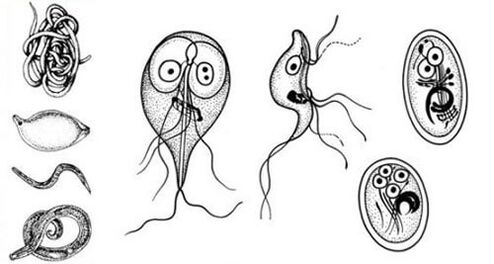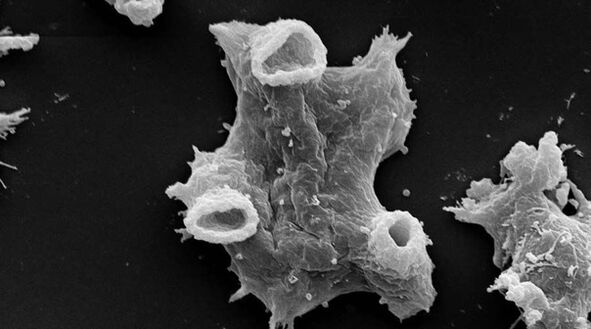Parasites that are constantly present in the human body and feed on its "juices" are commonly referred to as parasitic protozoan microorganisms. They have nothing to do with worms, but some single-celled parasites can reach large sizes.

Although they have lost their digestive vacuoles due to lifestyle, they are completely independent organisms.
Parasite classes
Representatives of different organisms can be classified as follows:
- Sarcode- Negleria and amoeba.
- spores- Toxoplasma Plasmodium.
- eyelashes- balantidium
- Flagella- Leishmania, Trichomonas, Tripanosomes and Giardia.
These organisms are one of the first simple organisms to appear on the planet. Their elementary structure and functional functions can lead to the development of deadly diseases. The list includes general representatives of protozoa parasites, but there are many more.
Effects on the body
Although these parasites are called protozoa, they have a very negative effect on the human body and cause serious diseases.
Sarcode
dysenteric amoeba (Entamoedahistolytica).The parasite is found in most warm countries. One feature is the lack of skeletal and shell joints. It has legs to move. It can form cysts in the human body.
When the intestinal wall is affected, it often causes amoebiasis. A person has bloody loose stools. It is very difficult to diagnose such an amoeba. It is a very dangerous parasite.
Negleria Fowler.Man is an intermediate host. The location of the parasite is usually the brain.
Amoebae often cause fatal meningoencephalitis.
Flagella
trichomonas (Trichmonasvaginalis).The disease occurs in men with almost no symptoms, only in the form of transmission. In women, this is manifested by obvious signs of inflammation: profuse discharge with an unpleasant odor, itching and pain in the lower abdomen.
This is the simplest parasite, usually transmitted sexually, but it also happens through contact. Infected women can infect their babies during childbirth.
Giardia.These microorganisms parasitize the gastrointestinal tract. The effect on the body consists of cysts for many years, but the disease persists in a mild form. Rarely chronic. By the way, they are not afraid of toxins and ultraviolet radiation.
spores
leishmaniasis (Leishaniaspp).This species is localized in almost all human organs and eventually destroys them. Causes a serious disease - visceral leishmaniasis. There is a constant void in their habitat. It is difficult to treat and often requires surgery.
Plasmodium malaria.Localized in blood plasma, erythrocytes and liver cells. What's worse is that these simple organisms destroy red blood cells. Causes tropical and multi-day malaria. It can seriously damage the kidneys and damage the nervous system.
Toxoplasmosis.Affects lymph nodes and small intestine. Toxoplasmosis, which is very dangerous for pregnant women, often develops. It mimics a viral infection in the early stages of infection.
eyelashes
Intestinal balantidia (Balantidiumcoli).It usually affects the large intestine, especially the intestines. It is a fairly large single-celled organism that easily enters the bloodstream.
They do not cause much damage to the body, but can cause ulcers in the intestines.
Symptoms and diseases caused by protozoa parasites
To date, a number of pathogens have been identified that cause the following diseases:
- Giardiasis.
- malaria.
- Leishmaniasis.
- Trichomoniasis.
- Cryptosporidiosis.
- Balantidosis.
dysenteric amoeba
Infection occurs through food and household items.
Symptoms of mild disease:
- Flatulence.
- Abdominal cramps.
- Constipation is replaced by diarrhea.
Moderate severity of the disease:
- Symptomatology increases within 10 days.
- There is weakness and anorexia.
- Mucus with blood.
- Plenty of feces.
When the disease becomes chronic, the weight decreases sharply.
Pathologies caused by this parasite:
- Peritonitis.
- Amoebic appendicitis.
- Dysentery.
- Abscesses of the lungs and liver.
- Very rare amoebic hepatitis and brain abscess.
- Skin amebiasis with the development of ulcers and erosions.
Even fatalities are possible in people who are weakened by the lightning fast course of the disease.
Naegleria fowleri (Naegleria fowleri)

You can catch this parasite both while swimming in the pond and by air.
The disease always begins with the manifestation of acute symptoms:
- Loss of sense of smell and taste.
- Headache and weakness.
- Nausea and vomiting.
- Loss of coordination of movements.
- Pulmonary edema may develop.
- Hallucinations and convulsions.
The disease is very difficult to diagnose, so it often ends in the death of the patient.
Negleriya causes the following pathologies:
- Amoebic meningoencephalitis.
- Negleriosis.
- Destroys the brain.
- A person often falls into a coma.
The infection is often fatal.
lambliya
Diseases occur without acute symptoms. The infection is transmitted through unwashed fruits and dirty hands.
Typical symptoms:
- Increased saliva.
- Abdominal discomfort.
- Anorexia and nausea.
Sometimes there is a green stool with foam and a pungent odor.
Causes: giardiasis and various intestinal dysfunctions.
Leishmania
Infestation is caused by mosquitoes.
It manifests itself with severe symptoms:
- Enlargement of the spleen and liver.
- High temperature rise.
- Fever conditions.
- Weakness and pallor of the skin.
- Bleeding on the skin.
- Problems with heart function.
- Anemia and severe weight loss.
Sometimes edema and pneumonia can combine.
This parasite leads to cachexia, decreased muscle tone, impotence and heart failure.
Trichomonas
Infection occurs through sexual contact and hygiene. Symptoms are mostly absent, but sometimes appear.
For men:
Anxiety when urinating.
- There is blood in the sperm.
- White discharge.
Among women:inflammation of the cervix and vagina.
The infection is very dangerous for pregnant women, as it can lead to premature birth.
Plasmodium malaria
Mosquito bites cause infection.
Plasmodium vivax.Symptoms depend on the stage of the disease:
- Vibration for up to 3 hours - muscle and joint pain, pain in the liver.
- Fever for about 12 hours - temperature up to 40 degrees, hypotension, shortness of breath and tachycardia.
- Intense sweating phase - a sharp decrease in temperature with the release of sweat, muscle weakness and hypotension.
Three-day malaria may develop and spontaneous recovery may occur. There may be enlarged spleen, anemia and sometimes jaundice.
Plasmodium malaria.Fever attacks occur in the morning and evening. There are also three-day malaria symptoms. It can lead to the development of nephrotic syndrome, which is difficult to treat.
Plasmodium oval.Fever attacks only come in the evening. The disease progresses quite easily, but the liver may increase slightly.
Toxoplasmosis
The ways of infection are quite wide. You can get it from half-cooked meat, dirty products, blood transfusions and skin cuts. By the way, the infection of a pregnant woman is often transmitted to the fetus.
In the acute form of the disease, the following symptoms appear:
- Open enlargement of the liver and spleen.
- Signs of jaundice.
- Itchy skin.
- Symptoms characteristic of meningitis and encephalitis.
- Lymph nodes dilate.
Chronic form:
- High temperature for a long time.
- Pain in muscles and bones.
- In women, the menstrual cycle is disrupted.
- There are headaches and nervousness.
In addition, there may be problems with the thyroid gland and adrenal insufficiency.
Infection with parasites of this class threatens the development of many diseases:
- Oligophrenia.
- Toxoplasmosis.
- epileptic seizures.
- Inflammation of the retina.
- hepatolienal syndrome.
Rarely, but still, sclerosis of the lymph nodes occurs.
Balantidia intestine
You can catch the parasite through unboiled water, dirty hands and fruit.
Signs of infection:
- With prolonged diarrhea, pus and blood.
- Abdominal pain syndrome.
Balantidia leads to the development of peritonitis, organ abscesses and perforation of the intestinal wall.
The result
Infection with protozoa is very similar to infection with viruses. By definition, they are not considered worms, although they cause great harm to human health.
Infection with protozoa parasites can be fatal, so you should see a doctor immediately when typical symptoms appear. Self-medication is strictly prohibited.






































